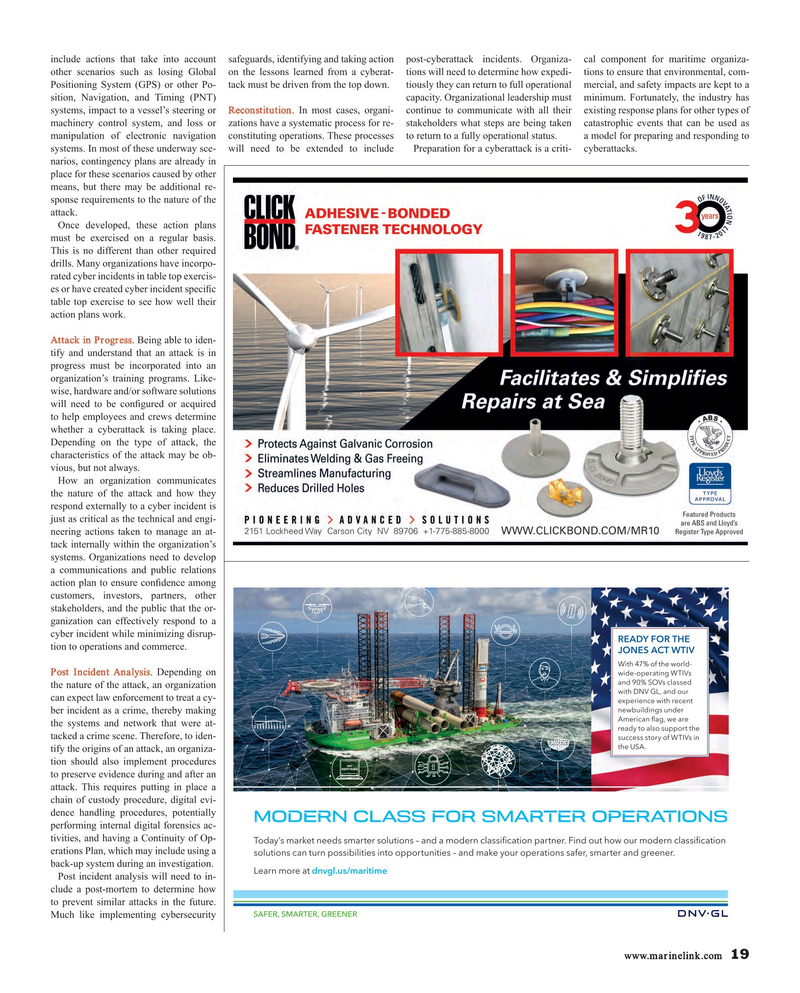
Page 19: of Maritime Reporter Magazine (April 2018)
Offshore Energy Annual
Read this page in Pdf, Flash or Html5 edition of April 2018 Maritime Reporter Magazine
include actions that take into account safeguards, identifying and taking action post-cyberattack incidents. Organiza- cal component for maritime organiza- other scenarios such as losing Global on the lessons learned from a cyberat- tions will need to determine how expedi- tions to ensure that environmental, com-
Positioning System (GPS) or other Po- tack must be driven from the top down. tiously they can return to full operational mercial, and safety impacts are kept to a sition, Navigation, and Timing (PNT) capacity. Organizational leadership must minimum. Fortunately, the industry has systems, impact to a vessel’s steering or Reconstitution. In most cases, organi- continue to communicate with all their existing response plans for other types of machinery control system, and loss or zations have a systematic process for re- stakeholders what steps are being taken catastrophic events that can be used as manipulation of electronic navigation constituting operations. These processes to return to a fully operational status. a model for preparing and responding to systems. In most of these underway sce- will need to be extended to include Preparation for a cyberattack is a criti- cyberattacks.
narios, contingency plans are already in place for these scenarios caused by other means, but there may be additional re- sponse requirements to the nature of the attack.
Once developed, these action plans must be exercised on a regular basis.
This is no different than other required drills. Many organizations have incorpo- rated cyber incidents in table top exercis- es or have created cyber incident speci? c table top exercise to see how well their action plans work.
Attack in Progress. Being able to iden- tify and understand that an attack is in progress must be incorporated into an organization’s training programs. Like- wise, hardware and/or software solutions will need to be con? gured or acquired to help employees and crews determine whether a cyberattack is taking place.
Depending on the type of attack, the characteristics of the attack may be ob- vious, but not always.
How an organization communicates the nature of the attack and how they respond externally to a cyber incident is just as critical as the technical and engi- neering actions taken to manage an at- tack internally within the organization’s systems. Organizations need to develop a communications and public relations action plan to ensure con? dence among customers, investors, partners, other stakeholders, and the public that the or- ganization can effectively respond to a cyber incident while minimizing disrup-
READY FOR THE tion to operations and commerce.
JONES ACT WTIV
With 47% of the world-
Post Incident Analysis. Depending on wide-operating WTIVs and 90% SOVs classed the nature of the attack, an organization with DNV GL, and our can expect law enforcement to treat a cy- experience with recent newbuildings under ber incident as a crime, thereby making
American ?ag, we are the systems and network that were at- ready to also support the tacked a crime scene. Therefore, to iden- success story of WTIVs in the USA. tify the origins of an attack, an organiza- tion should also implement procedures to preserve evidence during and after an attack. This requires putting in place a chain of custody procedure, digital evi- dence handling procedures, potentially
MODERN CLASS FOR SMARTER OPERATIONS performing internal digital forensics ac- tivities, and having a Continuity of Op-
Today’s market needs smarter solutions – and a modern classi?cation partner. Find out how our modern classi?cation erations Plan, which may include using a solutions can turn possibilities into opportunities – and make your operations safer, smarter and greener. back-up system during an investigation.
Learn more at dnvgl.us/maritime
Post incident analysis will need to in- clude a post-mortem to determine how to prevent similar attacks in the future.
Much like implementing cybersecurity www.marinelink.com 19
MR #4 (18-25).indd 19 MR #4 (18-25).indd 19 4/5/2018 9:10:05 AM4/5/2018 9:10:05 AM

 18
18

 20
20
